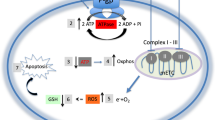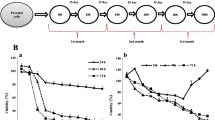Abstract
The influence of the antiestrogen tamoxifen (TAM) on the activity of mitoxantrone (MXN), was evaluated against wild-type MCF-7/WT and their multidrug-resistant variant MCF-7/ADR cells. Multidrug resistance (MDR) in this cell line which was selected for resistance to Adriamycin (ADR), is associated with increased expression of P-glycoprotein (P-gp). In a clonogenic assay it was observed that TAM (1–10 μM) significantly enhanced the activity of MXN in the MCF-7/ADR but not in the drug-sensitive cell line. Isobologram analysis indicated that the effect of the combination was additive in the parental MCF-7/WT cells and strongly synergistic in the MDR MCF-7/ADR cells. Also, TAM (10 μM) caused a three-fold increase in the steady-state levels (Css) of MXN in MCF-7/ADR cells but did not modulate MXN levels in MCF-7/WT cells. The observed synergism in MCF-7/ADR cells was perhaps due to the increase in Css of MXN that may involve interaction of TAM with P-gp. The combination of MXN and TAM may be useful in the treatment of drug-sensitive and drug-resistant breast cancer.
Similar content being viewed by others
References
Batist G, Tulpule A, Sinha BK, Katki AG, Myers CE, Cowan KH (1986) Overexpression of novel anionic glutathione transferase in multidrug resistant human breast cancer cells. J Biol Chem 261:15544
Benjamin RS, Chawla SP, Ewer MS, Carrasco H, Mckay B, Holmes F (1985) Evaluation of mitoxantrone cardiac toxicity by nuclear angiography and endomyocardial biopsy: an update. Invest New Drugs 3:117
Berenbaum MC (1981) Criteria for analyzing interactions between biologically active agents. Adv Cancer Res 35:269
Berman E, Adams M, Duigou-Osterndorf R, Godfrey L, Clarkson B, Andreeff M (1991) Effect of tamoxifen on cell lines displaying multidrug resistance phenotype. Blood 77:818
Bradford M (1976) A rapid and sensitive method for quantitation of microgram quantities of proteins utilizing the principle of protein-dye binding. Anal Biochem 72:248
Buckley MT, Goa KL (1989) Drug evaluation: tamoxifen-A reappraisal of its pharmacodynamic and pharmacokinetic properties, and therapeutic uses. Drugs 37:451
Cantwell B, Carmichael J, Millward MJ, Chatterjee M, Harris AL (1989) Intermittent high dose tamoxifen (HDT) with oral etoposide (EPO): phase I and II clinical studies. Br J Cancer 8:450
Chaterjee M, Harris AL (1990) Reversal of acquired resistance to adriamycin in CHO cells by tamoxifen and 4-hydroxytamoxifen: role of drug interaction with alpha-1 acid glycoprotein. Br J Cancer 62:712
Chou TC, Talalay T (1984) Quantitative analysis of dose effect relationshipL the combined effects of multiple drugs or enzyme inhibitors. Adv Enzyme Regul 22:27
Clarke R, Currier S, Kaplan O, Lovelac E, Boulay V, Gottesman MM, Dickson RB (1992) Effect of P-glycoprotein expression on sensitivity to hormones in MCF-7 human breast cancer cells. J Natl Cancer Inst 84:1506–1512
Dalton WS, Durie BGM, Alberts DS, Gerlach JH, Cress AE (1988) Characterization of a new drug-resistant human myeloma cell line that expressed P-glycoprotein. Cancer Res 46:5125
Damle BD, Rajagopalan S, Desai PB (1994) Dipyridamole modulates multidrug resistance and intracellular as well as nuclear levels of doxorubicin in B16 melanoma cells. Int J Cancer 56:113
Deffie AM, Alam T, Seneviratne C, Beenken SW, Batra JK, Shea TC, Henner WD, Goldenberg GJ (1988) Multifactorial resistance to adriamycin: relationship of DNA repair, glutathione transferase activity, drug efflux, and P-glycoprotein in cloned cell lines of adriamycin-sensitive and-resistant P388 leukemia. Cancer Res 48:3595
Fairchild CR, Ivy SP, Kao-Shan C, Peng-Whang J, Rosen M, Israel MA, Melera PW, Cowan KH, Goldsmith ME (1987) Isolation of amplified and overexpressed DNA sequences from Adriamycin resistant human breast cancer cells. Cancer Res 47:5141
Gerlach JH, Kartner N, Bell DR, Ling V (1986) Multidrug resistance. Cancer Surv 5:25
Goldstein LJ, Galski H, Fojo AT, Willingham MC, Lai SL, Gazdar A, Piker R, Green A, Crist W, Brodfeur GM, Lieber M, Cossman J, Gottesman MM, Pastan I (1989) Expression of a multidrug resistance gene in human tumors and tissues. J Natl Cancer Inst 81:116
Hainsworth JD, Andrews MB, Johnson DH, Greco FA (1991) Mitoxantrone, fluorouracil and high dose leucovorin: an effective well tolerated regimen for metastatic breast cancer. J Clin Oncol 9:1731
Harker WG, Slade DL, Dalton WS, Meltzer PS, Trent JM (1989) Multidrug resistance in mitoxantrone-selected HL-60 leukemia cells in the absence of P-glycoprotein overexpression. Cancer Res 49:4542
Henderson CI, Allegra JC, Woodcock T, Wolff S, Bryan S, Cartwright K, Dukart G, Henry D (1986) Randomized clinical trials comparing mitoxantrone with doxorubicin in previously treated patients with metastatic breast cancer. J Clin Oncol 4:672
Jordan VC, Robinson SP, Welsons WW (1989) Resistance to antiestrogen therapy. In: D. Kessel (ed) Resistance to antineoplastic drugs. CRC Press, Boca Raton, p 403
Kirk J, Houlbrook S, Stuart NSA, Stratford IJ, Harris AL, Carmichael J (1993) Differential modulation of doxorubicin toxicity to multidrug and intrinsically drug resistant cell lines by anti-oestrogens and their major metabolites. Br J Cancer 67: 1189–1195
Leonessa F, Jacobson M, Boyle B, Lippman J, McGarvey M, Clarke R (1994) Effect of tamoxifen on the multidrug-resistant phenotype in human breast cancer cells: isobologram, drug accumulation, and Mr 170,000 glycoprotein (gp 170) binding studies. Cancer Res 54:441–447
Neidhart JA, Gochnour D, Roach R, Hoth D, Young D (1986) A comparison of mitoxantrone and doxorubicin in breast cancer. J Clin Oncol 4:672
Pastan I, Gottesman MM (1991) Multidrug resistance. Annu Rev Med 42:277
Peng YM, Ormberg D, Alberts DS (1982) Improved high performance liquid chromatography of the new antineoplastic agents bisanterene and mitoxantrone. J Chromatogr 233:235
Posner LE, Dukart G, Goldberg J, Bernstein T, Cartwright K (1985) Mitoxantrone: an overview of safety and toxicity. Invest New Drugs 3:123
Powles TJ, Smith IE, Ford HT, Combers RC, Mary J, Gazet JC (1980) Failure of chemotherapy to prolong survival in a group of patients with metastatic breast cancer. Lancet 1:580
Ramu A, Glaubiger D, Fuks Z (1984) Reversal of acquired resistance to doxorubicin in P388 murine leukemia cells by tamoxifen and other triparanol analogues. Cancer Res 44:4392
Riordan JR, Ling V (1985) Genetic and biochemical characterization of multidrug resistance. Pharmacol Ther 28:51
Sinha BK, Katki AG, Batist G, Cowan KH, Myers CE (1987) Differential formation of hydroxyl radicals by Adriamycin in sensitive and resistant MCF-7 human breast cancer tumor cells: implications for the mechanism of action. Biochem 26:3776
Soule HD, Vazquez J, Long A, Alberts S, Brennan M (1973) A human cell line from a pleural effusion derived from a breast carcinoma. J Natl Cancer Inst 51:1409
Tong W, Berman E, Lin S (1992) Pharmacokinetic study of high dose tamoxifen with daunorubicin: a phase I trial with escalation of tamoxifen. Proc Am Assoc Cancer Res 33:528
Tormey DC (1975) Adriamycin (NSC 123127) in breast cancer: an overview of studies. Cancer Chemother Rep 6:319
Trump DL, Smith DC, Ellis PG, Rogers MP, Schol SC, Winer EP, Panella TJ, Jordan VC, Fine RL (1992) High-dose oral tamoxifen, a potential multidrug-resistant-reversal agent: phase I trial in combination with vinblastine. J Natl Cancer Inst 84: 1811–1816
Van Hoff DD, Layard MV, Basa P (1979) Risk factors for doxorubicin-induced congestive heart failure. Ann Intern Med 91:710
Vickers PJ, Dickson RB, Shoemaker R, Cowan KH (1988) A multidrug resistant MCF-7 human breast cancer cell line which exhibits cross-resistance to antiestrogens and hormone-independent tumor growth in vivo. Mol Endocrinol 2(10):886
Author information
Authors and Affiliations
Rights and permissions
About this article
Cite this article
Desai, P.B., Bhardwaj, R. & Damle, B. Effect of tamoxifen on mitoxantrone cytotoxicity in drug-sensitive and multidrug-resistant MCF-7 cells. Cancer Chemother. Pharmacol. 36, 368–372 (1995). https://doi.org/10.1007/BF00686184
Received:
Accepted:
Issue Date:
DOI: https://doi.org/10.1007/BF00686184




